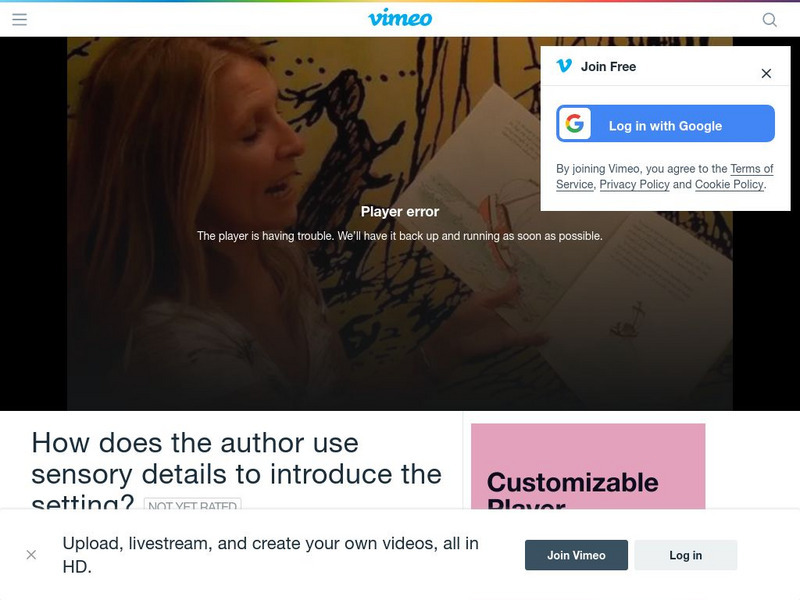Curated Video
Oh, How My Tree Inspires Me
Mr. Griot reviews figurative language and writes an original poem. He uses the poem to identify examples of simile, metaphor, idioms, personification, and alliteration.
Curated Video
Common Letter Sounds
Using the poem ”Peter Piper,” Miss Palomine introduces the student to the concept of common letter sounds. She gives an example of a common letter among words by going through the poem and identifying the -p words and their corresponding...
Curated Video
Seeing and Saying Same Sounds
Miss Palomine reviews the concept of common letter sounds. She and the student then look and listen for common letter sounds in a few sentences Miss Palomine uses as examples.
Lingokids
Bees Buzz
What's that buzzing in the air? It's our "Bees Buzz Chant!" Get ready to practice alliteration while learning about animals with the Lingokids friends.
Curated Video
Creating Meaning: Structure and Sound
This video will help students understand how poetry is organized and how the sound adds to the overall meaning of the written work.
Curated Video
Poetic Sounds
A video entitled “Poetic Sounds” which explores sound devices used in poetry, highlighting examples from several works by Edgar Allan Poe.
Curated Video
The Secret Service
They’re the shadowy agents who keep the President safe – but what is the Secret Service and why was it formed?
Curated Video
Employing Rhetorical Devices
The video entitled “Employing Rhetorical Devices” explores using rhetorical devices in a persuasive text.
Oxford Comma
Poetic Devices Explained: ALLITERATION (Definitions, Examples, and How to Use Them).
The second video in our series on poetic devices, in this video will look at repetition at the start of words: alliteration. By using examples from famous poets as well as the breakfast aisle, we'll look at how to identify and use...
Britlish
Walk and Work (subtitles)
The words walk and work, contain vowel sounds that are very similar and very difficult for many students, particular Russian students and those speaking Latin-based languages. This video English lesson is full of words containing these...
Communication Coach Alex Lyon
Rhetorical Devices For Persuasion
These Top 10 Rhetorical Devices for Persuasion and Public Speaking will enhance the persuasiveness of your speeches. These are also called Rhetorical Techniques or Literary Devices or that writers use in speeches and writing to enhance...
Britlish
Walk and Work (no subtitles)
The words walk and work, contain vowel sounds that are very similar and very difficult for many students, particular Russian students and those speaking Latin-based languages. This video English lesson is full of words containing these...
Schooling Online
English Essentials – Perfecting Poetry – How Soundscape is used to Convey Meaning in Poetry (Stage 4, Years/Grades 7-8)
Ever wondered why some poems flow smoothly, while others sound harsh and dissonant? It’s time to examine the soundscape of poetry. In this second lesson, we’ll delve into how poets create euphony and cacophony through a range of poetic...
Curated Video
GCSE Secondary English Age 13-17 - Vocabulary: Alliteration - Explained
SchoolOnline's Secondary English videos are brilliant, bite-size tutorial videos delivered by examiners. Ideal for ages 13-17, they cover every key skill in English Reading and Writing that students need to master in clear and easy to...
Curated Video
KS2 Primary English Age 9-13 - Vocabulary: Alliteration - Explained
SchoolOnline's Primary English videos are brilliant, bite-size tutorial videos delivered by examiners and skilled teachers. Ideal for ages 9-13, they cover every key skill in English Reading and Writing that students need to master in...
Communication Coach Alex Lyon
Communication Professor Reacts to I Have a Dream Speech by Martin Luther King, Jr.
Communication Professor Reacts to the I Have a Dream Speech from Martin Luther King, Jr.
Englishing
ESL - Literary Devices 2 (Alliteration, Imagery, Oxymoron, Hyperbole and Symbolism)
This is the second video lesson on literary devices. Mr. P. has published another video on literary devices on metaphors, simile, personification and onomatopoeia. In this video lesson, Mr. P. will discuss alliteration, imagery,...
Schooling Online
English Essentials - Perfecting Poetry - Sensory Imagery and Sound Devices (Stage 6, Years/Grades 11-12)
Let’s dive deeper into the world of poetry. In this second lesson, we’ll explore poetry with all five senses. Discover how poets use sound devices, sensory imagery, figurative language and much more! Soon, you’ll have all the tools you...
Cerebellum
The Elements Of Poetry - Overview
The Elements of Poetry - Figurative language, meter and rhyme, simile, and metaphor . these are a few of the many topics explored in this lively video tour through the genre of poetry. Other elements illustrated in the program include:...
Wonderscape
Literature Kids: Exploring Poetic Devices
In this video, the teacher discusses the fundamental poetic devices of alliteration, assonance, and consonance. They explain how these devices create rhythm and rhyme in poetry and provide examples from famous poets such as Walt Whitman...
Cerebellum
The Elements Of Poetry - Figurative Language
The Elements of Poetry - Figurative language, meter and rhyme, simile, and metaphor . These are a few of the many topics explored in this lively video tour through the genre of poetry. Other elements illustrated in the program include:...
Advocate of Wordz
Alliteration & Rhyme - Poetry Defined
Nothing sounds better than sounds that sound the same...I think that sounds about right...Alliteration and Rhyme, tends to retain an audience's attention longer and break past any self imposed barriers one puts up (yes, it happens *sad...
TED-Ed
Why Should You Read James Joyce's "Ulysses"?
What is Bloomsday? Why would thousands travel to Dublin on this day to visit sites depicted in a novel that is ridiculously hard to read? Why even bother with reading such a book? Find out by viewing a short video that suggests the...
Creek View Elementary School
Vimeo: How Does the Author Use Sensory Details to Introduce the Setting?
Watch an educator read a picture book, and practice identifying the sensory details as clues about the setting. [1:38]


